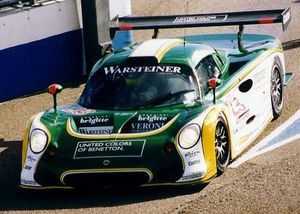.
Lotus Elise GT1

| |
| Lotus Elise GT1 | |
|---|---|
| Lotus | |
| aka | {{{aka (Type here, not up there)}}} |
| Production | {{{produced from when to when+total units made (optional)}}} |
| Class | {{{Class}}} |
| Body Style | {{{Body-Style}}} |
| Length | {{{length - type here}}} |
| Width | {{{Width - type here}}} |
| Height | {{{Height - type here}}} |
| Wheelbase | {{{wheelbase - type here}}} |
| Weight | {{{Weight - you get the point}}} |
| Transmission | {{{transmission + drive}}} |
| Engine | {{{engine}}} |
| Power | {{{Horsepower and Torque rating}}} |
| Similar | {{{similar (competition)}}} |
| Designer | {{{Designer (lead designer if it was a team effort)}}} |
The Lotus Elise GT1 (also known as the Lotus GT1 and known internally as Type-115) was a race car developed for grand tourer-style sports car racing starting in 1997.
Development
Lotus Cars had previous been using a racing version of their Lotus Esprit model in the BPR Global Endurance GT Championship since its foundation in 1994, competing in the premiere GT1 class against the likes of the McLaren F1 GTR, Venturi 600LM, Ferrari F40 GTE, and others. However in 1997 the series became known as the FIA GT Championship, and manufacturer involvement was increased with the new international exposure. Porsche was the first to start a new breed of racing car in 1996, with their purpose-built homologation special known as the 911 GT1. This was quickly followed by announcement that Mercedes-Benz planned to do the same with their CLK-GTR for 1997.
Thus Lotus decided that in order to remain competitive in the GT1 class, let alone be victorious, they would be required to follow the route set forth by Porsche and Mercedes-Benz. However, aware that they lacked the resources available that Porsche and Mercedes had to create not only the race cars but also the production supercars at a guarenteed loss of money for the company, Lotus decided to take an alternate route. Through interpretation of the rules for FIA GT, Lotus realized they would only need to build a single production car in order to meet homologation requirements. The car would not even need to be sold to a customer, it merely had to be built.
With this in mind, Lotus turned to designing their racing car. Lotus decided to abandon the aged Esprit chassis and instead turn to its new sportscar, the Elise. Mechnically, only the Elise's aluminium chassis was retained for the GT1, although it was heavily modified from its stock form. A new carbon fiber body that resembled the Elise was built, featuring a much longer length in order to increase the car's aerodynamic capabilities.
For an engine, Lotus knew that the Elise's stock straight-4 engine would not be able to compete, and so it was initially decided that the car would use the 3.5L V8 engine out of the old Esprit racing car, attached to a Hewland six-speed sequential gear box. This engine would only appear in the production car however, as testing proved that it was unreliable in comparison to the competition. Instead, the racing cars used Chevrolet LT5 6.0L V8 engines from the Chevrolet Corvette ZR-1, a car which Lotus had originally helped to develop when they had been owned by General Motors. With this, seven Elise GT1 racing chassis were built, going to factory teams GT1 Lotus Racing as well as privateer GBF UK, First Racing Project, and MVR Racing.
Racing history
Debuting at the first round of the 1997 FIA GT Championship season, the three factory Elise GT1s took to the grid. Unfortunately, their debut was short lived, as all three cars failed to finish, all due to alternator problems in the engine. For race two, privateer GBF UK received their two cars. Again the three factory cars suffered, failing to finish because of gearbox difficulty. GBF's Elise GT1s fared slightly better, with one of their entries actually finishing, although classified last and 25 laps down from the winner.
The third race of the season in Helsinki was a shorter race, featuring a smaller field. Only three Elise GT1s were entered, but GBF was able to succeed in taking 5th place, earning them points in the championship. The other two Elise GT1s also finished the race as well, an improvement for the company.
However as the season progressed, the teams began to suffer. After Helsinki was the 24 Hours of Le Mans, in which only a lone GT1 was entered due to concern over the ability of the car to last 24 hours. The car unfortunately did fail due to an oil leak after 121 laps. Returning to FIA at the Nürburgring, the full team managed to muster only 11th place, while at Spa they achieved 8th, but at Zeltweg all five cars failed to finish again. The teams did not attempt the Suzuka round, and again could only earn 12th place at Donington and 11th at Mugello when the series returned to Europe. The final two races in the United States saw only the factory team bring two cars, in which they managed a 13th and 9th place finish. The factory squad ended the season without any points, while GBF's points finish at Helsinki earned them 8th place in the championship.
Following the 1997 season, Lotus and its parent company, Proton, decided that the GT1 was not only lacking in pace in comparison to Porsche, Mercedes-Benz, and the older McLarens, but that it was also extremely expensive. The Chevrolet V8 was not a custom built race engine like its competitors leaving it lacking in top speed, and the chassis was too similar to a production car to compete with the exotic designs of other machines. The project was therefore cancelled and the factory team folded. The privateer teams also either folded or bought more capable machines.
Miraculously, in 2003 British squad Team Elite announced plans to purchase Elise GT1 chassis #05 and to use in in the 12 Hours of Sebring and 24 Hours of Le Mans in 2004 as a closed cockpit Le Mans prototype. This was similar to a plan by Panoz and French squad Larbre Compétition to use a Panoz Esperante GTR-1, a car which had originally competed with the Elise GT1 in FIA GT in 1997, as a closed cockpit prototype as well. The Elise would be modified to meet modern regulations as well as to attempt to bring the seven year old car up to speed. Unfortunately at Sebring the car proved its age, lasting a mere seven laps before its transmission failed. The project was promptly cancelled.
Bitter GT1
Former factory driver Mike Hezemans of the Netherlands, feeling that the Elise GT1's main faults were in its power and aerodynamics, decided that the car should not be abandoned. Buying two former Elise GT1 chassis, Hezemans turned to Bitter Cars of Germany to modify the car. The front end was made longer and smoother in an attempt to increase front downforce. To replace the Elise GT1's Chevrolet V8, Hezemans and Bitter turned to Chrysler, buying Viper GTS-R 8.0L V10s which were being used in their GT2 class racing cars. The new cars were named Bitter GT1s, and promised to compete in the 1998 FIA GT Championship season.
Unfortunately the cars were never able to match even the lackluster performance of the original Elise GT1s. The only race in which they actually competed, Silverstone, saw both Bitters failing to finish. After failing to even get past initial practice at Hockenheimring, the project was cancelled.
Road legal Lotus Elise GT1s
There are at least two road legal Lotus Elise GT1, both are believed to be converted race cars. One is in the uk, that car appied in an artical in evo magazine. The other is believed to be in holland.
Gallery
External links
http://www.supercars.net/cars/1035.html


